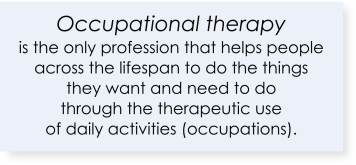Occupational Therapy at Minor Achievements provides services for children ages 3 to 15. These one-one-one, private sessions are tailored to meet individual needs. An occupational therapist (OT) is highly trained to evaluate and develop a treatment plan.
What is Occupational Therapy?
Occupational therapy (OT) treatment focuses on helping people of all ages to live life to its fullest by helping them promote health, and prevent—or live better with—injury, illness, or disability. OT can help kids with various needs improve their cognitive, physical, sensory, and motor skills and enhance their self-esteem and sense of accomplishment.
Some people may think that occupational therapy is only for adults; kids, after all, do not have occupations. But a child’s main job is playing and learning, and occupational therapists can evaluate kids’ skills for playing, school performance, and daily activities and compare them with what is developmentally appropriate for that age group. According to the American Occupational Therapy Association (AOTA), in addition to dealing with an someone’s physical well-being, OT practitioners address psychological, social, and environmental factors that can affect functioning in different ways. This approach makes OT a vital part of health care for some kids.
for adults; kids, after all, do not have occupations. But a child’s main job is playing and learning, and occupational therapists can evaluate kids’ skills for playing, school performance, and daily activities and compare them with what is developmentally appropriate for that age group. According to the American Occupational Therapy Association (AOTA), in addition to dealing with an someone’s physical well-being, OT practitioners address psychological, social, and environmental factors that can affect functioning in different ways. This approach makes OT a vital part of health care for some kids.
Occupational therapy is the only profession that helps people across the lifespan to do the things they want and need to do through the therapeutic use of daily activities (occupations).
What is the difference between Occupational Therapy (OT) and Physical Therapy (PT) ?
An occupational therapist treats the whole person. Whether they’re recovering from injuries or have developmental or cognitive disabilities affecting their motor skills, emotions or behavior, OTs are helping people to fully engage in daily life. An OT focuses on improving a client’s ability to perform activities of daily living (ADL) and deals more with fine motor skills, visual-perceptual skills, cognitive skills, and sensory-processing deficits.
A physical therapist treats the patient’s actual impairment from a biomechanical perspective. A PT works to get their patients in motion and prevent injuries. Physical therapy tries to improve the impairment itself by increasing mobility, aligning bones and joints, or lessening pain. PT’s focuses on improving a client’s ability to perform movement of the human body and deals with pain, strength, joint range of motion, endurance, and gross motor functioning.
Although the fields of occupational therapy and physical therapy serve different roles in health care, there is a lot of crossover between the two.
- Both educate people on how to prevent and avoid injuries.
- Both educate people about the healing process.
- Both assist people with improving their ability to perform daily activities through training and education.
- Both play very important roles and specialize in their areas of expertise.

Who Benefits from Occupational Therapy?
According to the AOTA, kids with these medical problems might benefit from OT:
 birth injuries or birth defects
birth injuries or birth defects- sensory processing disorders
- traumatic injuries (brain or spinal cord)
- learning problems
- autism/pervasive developmental disorders
- juvenile rheumatoid arthritis
- mental health or behavioral problems
- broken bones or other orthopedic injuries
- developmental delays
- post-surgical conditions
- burns
- spina bifida
- traumatic amputations
- cancer
- severe hand injuries
- multiple sclerosis, cerebral palsy, and other chronic illnesses
Occupational therapists might:
- help kids work on fine motor skills so they can grasp and release toys and develop good handwriting skills
- address hand–eye coordination to improve kids’ play and school skills (hitting a target, batting a ball, copying from a blackboard, etc.)
- help kids with severe developmental delays learn basic tasks (such as bathing, getting dressed, brushing their teeth, and feeding themselves)
- help kids with behavioral disorders maintain positive behaviors in all environments (e.g., instead of hitting others or acting out, using positive ways to deal with anger, such as writing about feelings or participating in a physical activity)
- teach kids with physical disabilities the coordination skills needed to feed themselves, use a computer, or increase the speed and legibility of their handwriting
- evaluate a child’s need for specialized equipment, such as wheelchairs, splints, bathing equipment, dressing devices, or communication aids
- work with kids who have sensory and attentional issues to improve focus and social skills
Andrea Schutz, MS, LOT
Pediatric Occupational Therapist
Andrea graduated with a degree in occupational therapy from Utica College of Syracuse University. She has a history working in the field of psychiatry at Johns Hopkins Hospital where she supervised Occupational Therapy students for 7 years. She has worked in the school system for over 20 years. She specializes in working with children on the Autism Spectrum. She has a listening ear that allows her to meet the child and family right where they are and help them. Andrea enjoys dancing, music, and taking a stroll on beautiful Clearwater Beach at sunset.



You must be logged in to post a comment.